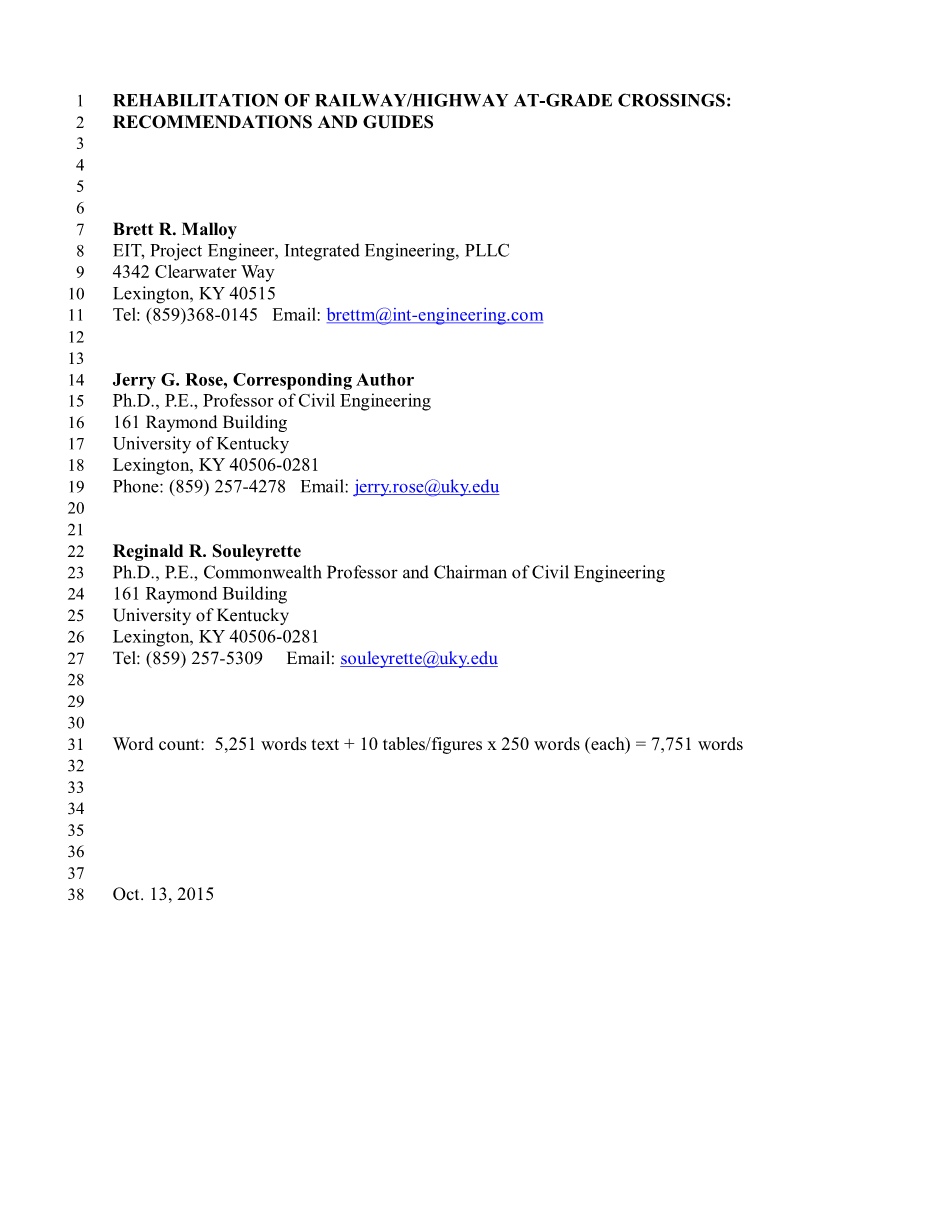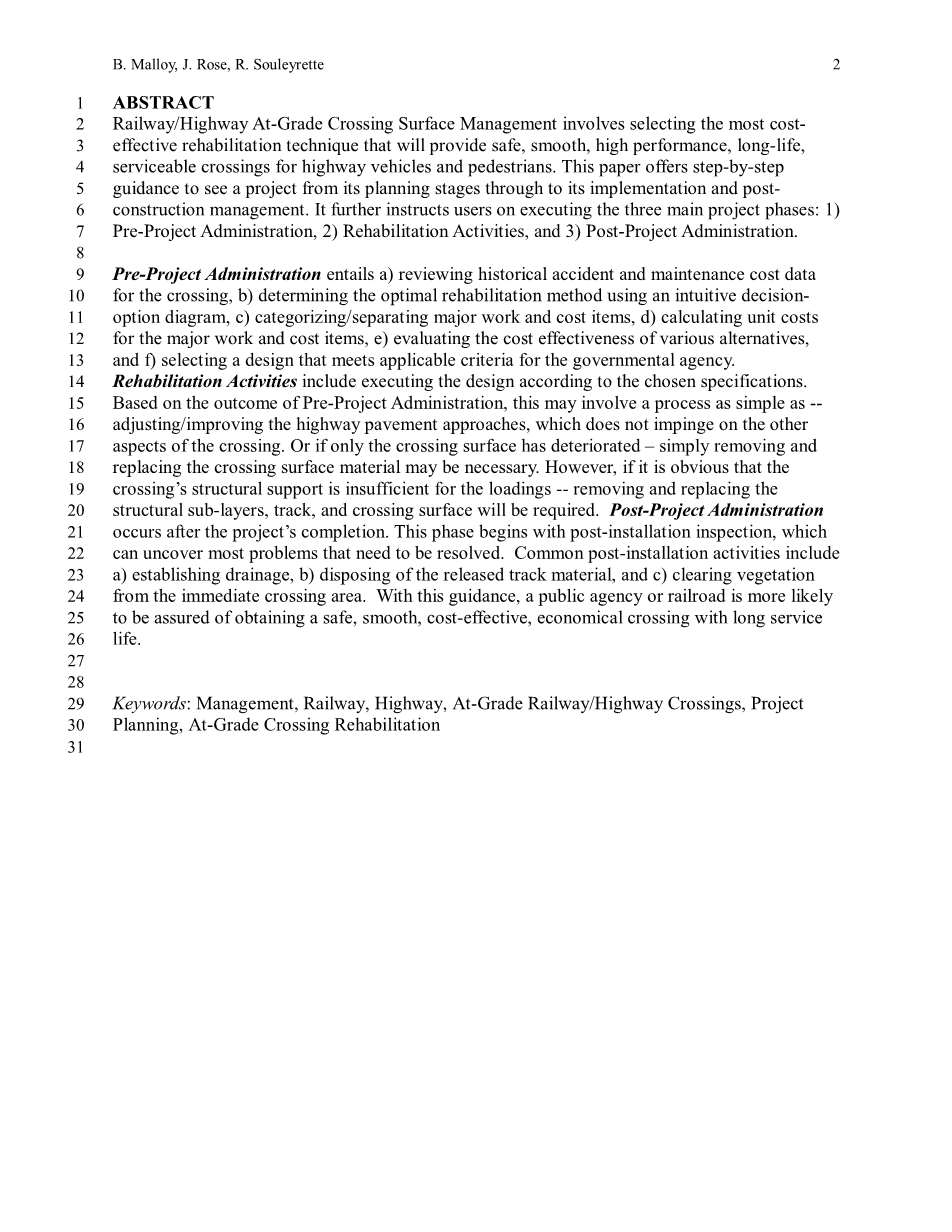

英语原文共 27 页,剩余内容已隐藏,支付完成后下载完整资料
REHABILITATION OF RAILWAY/HIGHWAY AT-GRADE CROSSINGS: 1 RECOMMENDATIONS AND GUIDES 2
Brett R. Malloy 7
EIT, Project Engineer, Integrated Engineering, PLLC 8
4342 Clearwater Way 9
Lexington, KY 40515 10
Tel: (859)368-0145 Email: brettm@int-engineering.com 11
Jerry G. Rose, Corresponding Author 14
Ph.D., P.E., Professor of Civil Engineering 15
161 Raymond Building 16
University of Kentucky 17
Lexington, KY 40506-0281 18
Phone: (859) 257-4278 Email: jerry.rose@uky.edu 19
Reginald R. Souleyrette 22
Ph.D., P.E., Commonwealth Professor and Chairman of Civil Engineering 23
161 Raymond Building 24
University of Kentucky 25
Lexington, KY 40506-0281 26
Tel: (859) 257-5309 Email: souleyrette@uky.edu 27
Word count: 5,251 words text 10 tables/figures x 250 words (each) = 7,751 words 31
Oct. 13,
ABSTRACT
Railway/Highway At-Grade Crossing Surface Management involves selecting the most cost-effective rehabilitation technique that will provide safe, smooth, high performance, long-life, serviceable crossings for highway vehicles and pedestrians. This paper offers step-by-step guidance to see a project from its planning stages through to its implementation and post-construction management. It further instructs users on executing the three main project phases: 1) Pre-Project Administration, 2) Rehabilitation Activities, and 3) Post-Project Administration.
Pre-Project Administration entails a) reviewing historical accident and maintenance cost data for the crossing, b) determining the optimal rehabilitation method using an intuitive decision-option diagram, c) categorizing/separating major work and cost items, d) calculating unit costs for the major work and cost items, e) evaluating the cost effectiveness of various alternatives, and f) selecting a design that meets applicable criteria for the governmental agency.
Rehabilitation Activities include executing the design according to the chosen specifications. Based on the outcome of Pre-Project Administration, this may involve a process as simple as -- adjusting/improving the highway pavement approaches, which does not impinge on the other aspects of the crossing. Or if only the crossing surface has deteriorated – simply removing and replacing the crossing surface material may be necessary. However, if it is obvious that the crossingrsquo;s structural support is insufficient for the loadings -- removing and replacing the structural sub-layers, track, and crossing surface will be required.
Post-Project Administration occurs after the projectrsquo;s completion. This phase begins with post-installation inspection, which can uncover most problems that need to be resolved. Common post-installation activities include a) establishing drainage, b) disposing of the released track material, and c) clearing vegetation from the immediate crossing area. With this guidance, a public agency or railroad is more likely to be assured of obtaining a safe, smooth, cost-effective, economical crossing with long service life.
Keywords: Management, Railway, Highway, At-Grade Railway/Highway Crossings, Project Planning, At-Grade Crossing Rehabilitation
INTRODUTION
This paper includes recommendations for Highway/Railway At-Grade Crossing Surface Rehabilitation that guide the reader through all aspects of project planning, implementation, and management. Specifically, it discusses: 1) pre-project administration, 2) strategies for determining appropriate rehabilitation procedures, 3) techniques for crossing installation, and 4) post-project administration. More detailed guidance may be found in Malloy, Purcell, and Rose (2014).
Rough crossing surfaces increase vehicle maintenance cost, may cause vehicle damage (to highway and rail vehicles), require more maintenance than surrounding rail or highway approaches, and cause discomfort and concern to the driving public. Good surfaces are also important to safety. While no studies have quantified the relationship between crossing surface and safety, it is known that in general, rough driving surfaces contribute to higher crash rates. Prevvious studies have shown that rough pavement can lead to more than a doubling of crash frequency (Chan, et. al., 2010).
Because crossings vary in terms of their structural properties and the type of corrective action required, it is not possible to adopt a comprehensive, unitary framework for rehabilitation that applies to all sites irrespective of context. Project engineers must evaluate each project individually and select the most appropriate solution based on this context. Before rehabilitation starts, it is imperative that engineers and project managers carefully analyze crossings so they develop a thorough knowledge of them. After a crossing has been evaluated, the information herein will assist users in carrying out each phase of the rehabilitation. It is important to note that the primary goal of these recommendations and guides is to facilitate the implementation of rehabilitation. Figure 1 contains a sample form that provides stakeholders a means to evaluate and summarize the condition of highway/railway at-grade crossings. The information for the initial six data classifications can be accessed on the Federal Railroad Administration Office of Safety web page (FRA 2015). All of the recommendations in this paper are designed to be cost-effective while being consistent with best practices. Using best practices maximizes the life cycle of at-grade crossings, improves rideability, reduces expenses incurred by the public agency, and develops a fast-track approach that minimizes traffic impediment.
全文共59364字,剩余内容已隐藏,支付完成后下载完整资料
资料编号:[13120],资料为PDF文档或Word文档,PDF文档可免费转换为Word


